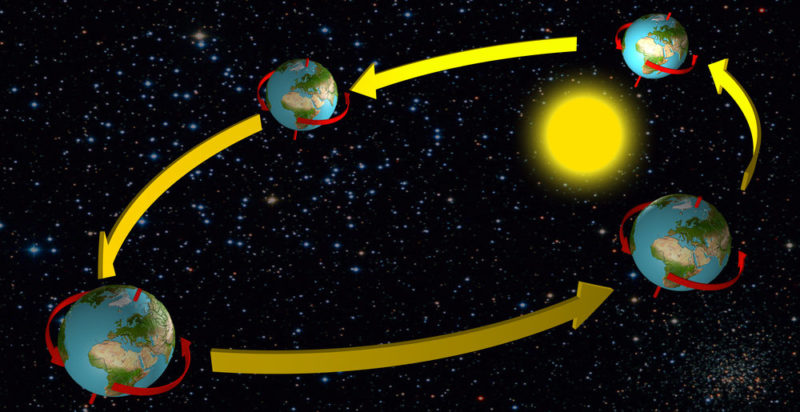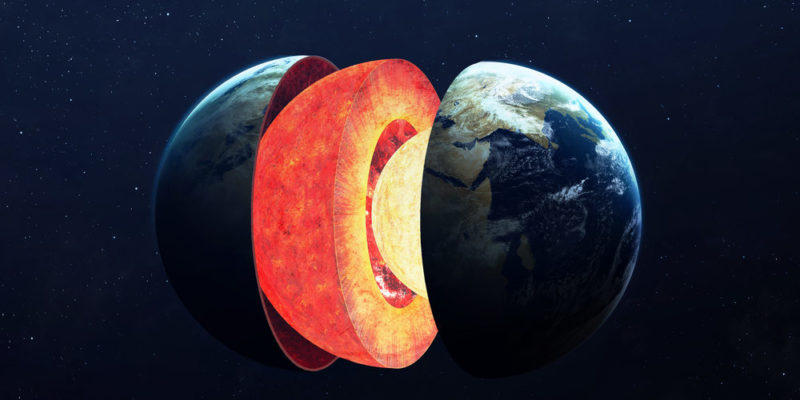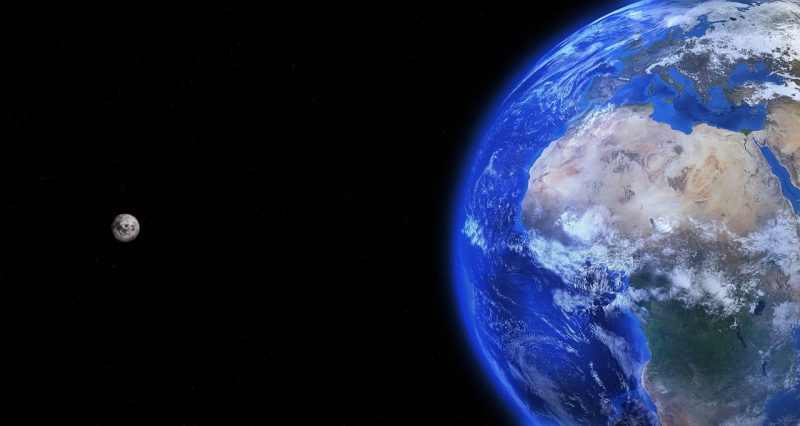We explain what the Earth is, how it originated and the movements of this planet. Also, its characteristics, biosphere, hydrosphere and more.
What is planet Earth?
Earth is the third planet in the solar system , orbiting the Sun between Venus and Mars , that is, 149,600,000 km from the Astro Rey. It is the largest and most dense of the so-called Terrestrial planets, and the fifth in size of the eight that exist. It is also the only planet to date capable of supporting organic life as we know it.
The Earth has a single natural satellite that we call the Moon , orbiting just 384,400 km from the surface. The Moon is the fourth largest satellite in the Solar System and measures a quarter of the Earth.
Origin and formation of the Earth
The origin of the Earth and other planets are in the solar nebula, a disk of matter remaining in the same formation of the sun . It has been calculated that 4,550 million years ago the Earth already existed, after a period of cooling and constitution of approximately 10 to 20 million years, the final result of which was the formation of the outer layers of the Earth's surface and the Moon. , product of an impact between a body roughly the size of Mars with the Earth about 4.53 billion years ago.
Then there was a gradual degassing of the planet's crust , which together with the incipient volcanic activity , initiated the chemical processes that would result in the Earth's atmosphere. Similarly, the appearance of water from the oceans , a prelude to life, was due to the introduction of ice and liquid water in comets, asteroids or protoplanets that made an impact on the young Earth.
Earth movements
 The Earth has three different forms of motion: rotation, translation, and skew.
The Earth has three different forms of motion: rotation, translation, and skew.
- Rotation. The Earth revolves around its own axis, in a West-East direction, and takes 23 hours, 56 minutes and 4 seconds to complete one revolution. This movement gives rise to day and night, alternating between the face exposed and hidden from the Sun.
- Translation. The Earth's orbit around the Sun has a perimeter of 930 million kilometers, at a speed of 108,000 kilometers per hour. That means one full orbital revolution takes place every 365 days, 5 hours, 48 minutes, and 45 seconds. This period is what we commonly call the year.
- Obliquity. The Earth leans on the plane of its elliptical by little more than 23 °, and is responsible for the seasons of the year, since it brings certain planetary latitudes closer to and further away from the Sun. This movement decreases at a rate of 0.47 ”per year.
Atmosphere of earth

The ball of gases that surrounds the earth's surface , caught by its force of gravity , is called the atmosphere. It is composed of 78% nitrogen , 21% oxygen and the rest of noble gases and extends from the earth's surface to about 11 km high (75% of its content). However, there are no definite limits to the atmosphere, as it begins to fade into space at some point.
Climatic phenomena and the redistribution of thermal energy are due to atmospheric nature , as well as the appearance of the ozone layer , essential for the preservation of life from the direct impact of UV radiation from the Sun.
Composition and internal structure of the Earth
 The Earth belongs to the terrestrial planets, that is to say, it is a rocky body and not a gaseous one, like Jupiter . The terrestrial body is made up of different geological levels or layers, namely:
The Earth belongs to the terrestrial planets, that is to say, it is a rocky body and not a gaseous one, like Jupiter . The terrestrial body is made up of different geological levels or layers, namely:
- Lithosphere. Composed of the earth's surface, crust and upper mantle, it is the layer that extends from 0 to 60 km deep. It is the coldest and most rigid layer of all. The tectonic layers are made up of this.
- Asthenosphere. A viscous layer on which the lithosphere floats, it goes from 100 to 700 km deep.
- The mantle . This is the name given to the layer between 35 and 2890 km deep, although it is a series of different geological levels.
- External nucleus. A liquid layer of matter , of very low viscosity, that surrounds and rests on a solid nucleus.
- Inner core. The central sphere of the Earth, composed mainly of iron , nickel and low percentages of sulfur and oxygen. The core in total is 3,500 km thick.
Proportions of the Earth

Of the terrestrial planets, Earth is the densest, possessing the most intense magnetic field and the highest surface gravity, as well as the fastest rotation. This shapes it as a flattened sphere (oblate spheroid) at its poles, slightly bulging at the equator .
It has an equatorial circumference of 40,091 km , a diameter of 12,756 km, and a mass of 5,973 x 10 24 kg.
Earth's surface
The earth's surface changes over the years , due to the underground movement of tectonic plates , whose folds and collisions generate various relief phenomena.
Biosphere

The biosphere is understood to be the total set of organic life on the planet , in the context of its physical locations. Divided into various biomes , according to their latitude, height above sea level and humidity margins, it is estimated that it began to evolve 3.5 billion years ago.
The biodiversity planetary is very high, thereby giving priority to low areas and humid as Rainforest while high arid areas and are less habitable for life vegetable and animals .
In each biome there are various ecosystems , in which life has organized itself from the possible relationships between living beings . The total mass of life on the planet is roughly 1 trillion tons of carbon .
Hydrosphere
 A fundamental difference of the Earth with respect to other planets of the Solar System is its abundant presence of water . This total water surface is known as the hydrosphere, and it encompasses not only the vast oceans and seas , but also lakes , rivers and groundwater up to 2 kilometers deep. The sum of this mass of water on the planet is 1/4400 of its total mass.
A fundamental difference of the Earth with respect to other planets of the Solar System is its abundant presence of water . This total water surface is known as the hydrosphere, and it encompasses not only the vast oceans and seas , but also lakes , rivers and groundwater up to 2 kilometers deep. The sum of this mass of water on the planet is 1/4400 of its total mass.The oceans extend over an area of 361.84 × 10 6 km 2 , with an average depth of 3682.2 meters and a volume of 1.3324 × 10 9 km 3 . That means that if the land were completely leveled, the water would cover it completely up to 2.7m in height.
Earth's magnetic field
The Earth's magnetic field is the largest of the terrestrial planets . Its poles are identified with the geographical poles, although its origin is supposed in the movement of the planet's metallic core, which generates electrical currents.
This is how the magnetosphere is formed , the Earth's magnetic field that, among other things, deflects particles from the solar wind. The dipole magnetic moment of the planet is estimated at 7.91 × 10 15 T m 3 . This magnetic force weakens towards the equator.
It can help you: Earth magnetism .
Human population
 Spread over the continents, we live in the world about 7 billion human beings and this figure is expected to reach 9.2 billion by the year 2050. The most populated continent is Asia , and world statistics point to 40% of rural population versus 60% of urban population.
Spread over the continents, we live in the world about 7 billion human beings and this figure is expected to reach 9.2 billion by the year 2050. The most populated continent is Asia , and world statistics point to 40% of rural population versus 60% of urban population.The various human nations (204 sovereign nations as of 2011) have claimed almost all of the land surface , except for large areas of Antarctica and an unclaimed area between Egypt and Sudan, called Bir Tawil. Even so, only one-eighth of the earth's surface is habitable by humans.
The above content published at Collaborative Research Group is for informational and educational purposes only and has been developed by referring to reliable sources and recommendations from technology experts. We do not have any contact with official entities nor do we intend to replace the information that they emit.
Anas is an editor of a prestigious publishing company in the United States. She studied Mathematics in Arizona. Anas is also a teacher and one of her long-term goals is to build an institution that offers free education to everyone who are financially not stable. .
Leave a reply
Your email address will not be published. Required fields are marked *Recent post

Sport: What Is It, Types, Risks, Features, Characteristics and Examples

Dogs: Emergence, Features, Characteristics, Feeding and Breeds

Story: Definition, Elements, Structure, Features and Characteristics

